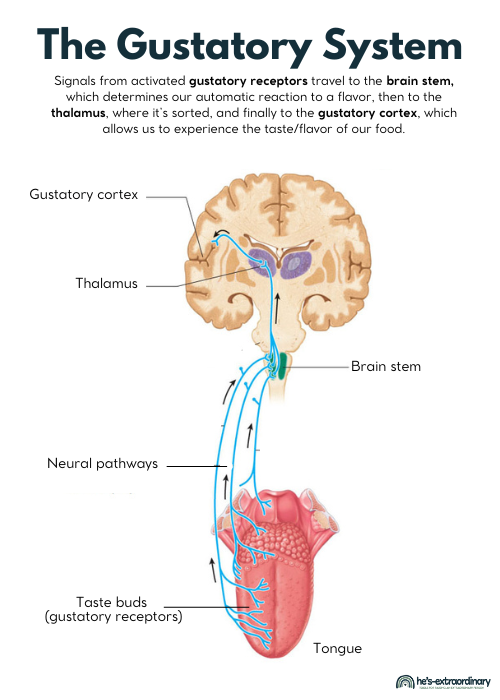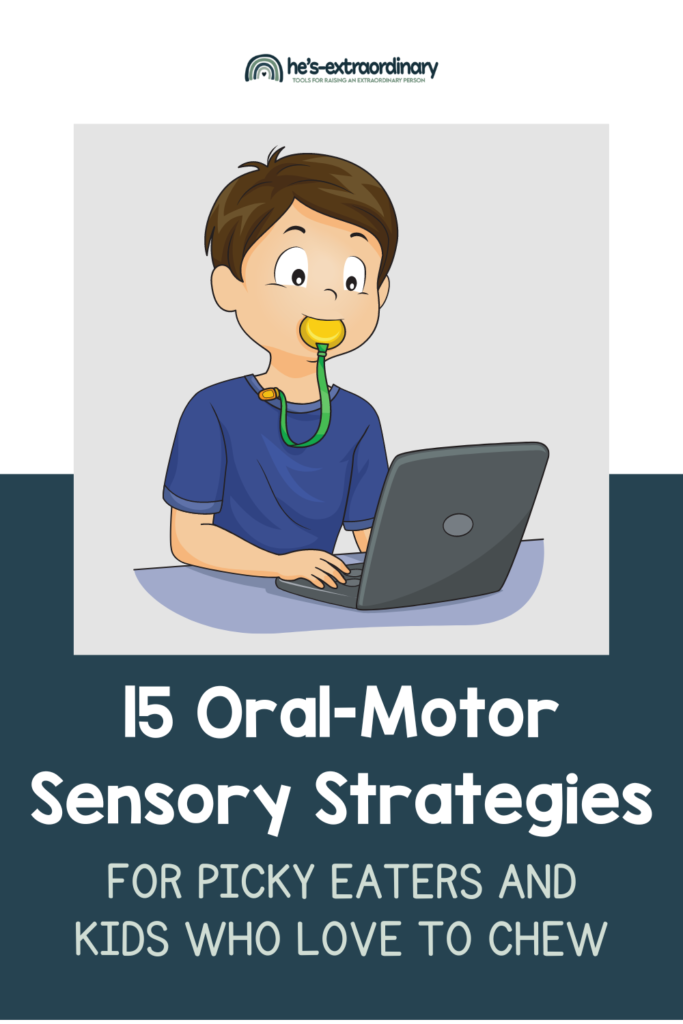The Oral-Motor System and The Gustatory System
What’s inside this article: A look at how the gustatory system (our sense of taste) works and an overview of the oral-motor system, which is the system connecting our senses inside the mouth.
Disclaimer: This post contains affiliate links.
This post is part of a 10-part series on the sensory systems. Each part will contain a table of contents to help you easily navigate through the entire series.
Table of Contents:
- Introduction – The Sensory Spectrum
- The Tactile System
- The Auditory System
- The Visual System
- Proprioception
- Vestibular System
- Interoception
- The Olfactory System
- The Oral-Motor System
- Bilateral Coordination
What is the Gustatory System, and How Does it Work?
The gustatory system is the sensory system responsible for our sense of taste. It influences our food preferences and eating behaviors. It is a complex process that involves the detection of taste substances (taste stimuli) in the mouth.
The gustatory system works closely with the olfactory system. Both taste and smell are needed to experience flavors fully. That’s why foods often taste more bland when our sense of smell is impaired, like when we have a cold.
We taste something when the taste substances interact with taste receptors located on the taste buds. Taste substances or flavor cells can be categorized into five basic tastes: sweet, sour, salty, bitter, and umami (savory).
Most taste buds are on the tongue but are also located in other parts of the mouth and throat.
The process of tasting involves several steps:
Taste Reception:
Your tongue is porous. These pores are called papillae. If you look at your tongue in the mirror, you will actually see the papillae. And all of your taste buds are located inside of these papillae. Each papilla has between 5 and 1000 taste buds inside it.
Your taste buds are composed of gustatory receptors. These are the sensory receptors that detect flavors and then relay sensory information to the brain.
There can be anywhere from 10 to 50 gustatory receptors per taste bud (and 5 to 1000 taste buds per pore). If you did the math, that’s a lot of sensory receptors.
Each taste bud contains taste receptor cells sensitive to specific taste types. The chemical structure of flavor cells determines which gustatory receptors are activated. For example, you don’t taste chocolate with the same taste buds that you use to taste a hot pepper.
Signal Transduction:
Taste substances (mainly foods, but other items can activate receptors, too) dissolve in saliva and interact with taste receptors on the taste buds to activate them.
When these receptors are activated, they initiate a series of cellular events that result in the generation of electrical signals.
Next, activated receptors initiate a nerve impulse, sending the message through the neural pathway, to the brain.
Brain Stem:
While examining the other senses, you may have noticed that neural signals typically go straight to their sensory cortex, where the brain interprets them, and then a response is generated.
The gustatory system is a little different. Signals from this system make a pit stop at the brainstem first before traveling to the gustatory cortex.
The brainstem determines what unconscious reaction to taste you’ll have. For example, if the taste is unpleasant, your brain stem may trigger nausea or cause gagging as an automatic reaction.
This happens before you actually taste the food (although the whole thing happens so quickly that you won’t be able to tell).
Thalamus:
After the brain stem gets the message, it’s sent to the thalamus.The thalamus is the sorting center of the brain.
It receives all types of sensory messages—not just taste but also sight, sounds, touch, etc. The thalamus’s job is to direct these messages to the right part of the brain for further processing. So, taste messages pass through the thalamus and onto the gustatory cortex.
Gustatory Cortex
The final destination is the gustatory cortex. This part of the brain allows us to taste the food.
It analyzes the message, and we recognize if a flavor is sweet, sour, salty, bitter, or savory. This part of the brain helps you enjoy your food and decide when you’re done eating.
Signals from the olfactory system also go to the gustatory cortex because smell plays a large role in taste.

The Oral Motor System
The oral motor system is a complex system that involves all of the senses inside the mouth, and it’s what creates the entire experience of any oral input.
This system includes our lips, tongue, jaw, and cheeks, which work together to allow for eating, drinking, and talking.
- The need to chew, bite and suck comes from the proprioceptive input that we receive from pressure and movement in our jaws.
- How things taste comes from both the gustatory and olfactory systems.
- The tactile system detects the texture, consistency, and temperature of food.
- Oral sensory processing doesn’t only affect eating. It also affects the way we move our mouth, control saliva, and produce sounds for speech.
How the sensory systems work together affects all sensory processing issues within the oral motor system.
Sensory Processing Challenges Related to the Oral Motor System
As mentioned, multiple sensory systems and how they work together impact sensory processing issues inside the mouth. Here are some examples:
- Food aversions may be from hypersensitivity to tactile input. This can make certain textures unbearable. If this is the case, your child might avoid certain foods. Or, they may refuse to eat foods that have more than one texture. For example, refusing to eat cereal with milk because the cereal is crunchy and the milk is a smooth liquid.
- If your child has a hyper-sensitive proprioceptive system, they may prefer soft foods. If their system is hypo-sensitive, they may prefer foods that are crunchy or chewy and enjoy thick drinks like smoothies and milkshakes through a straw.
- Some people naturally have more taste buds, which makes them experience taste more strongly. For example, they may be highly sensitive to certain flavors – or all flavors – and they may prefer to eat a very bland diet.
- Each taste bud is surrounded by tactile receptors that perceive the temperature of food. Having more taste buds also means there are more pain receptors on the tongue, so they may be particularly sensitive to hot foods and spicy flavors.
Signs of Oral Processing Hyper-Sensitivity (Over Responsive)
- Gags or chokes often while eating
- Has trouble using a straw
- Picky
eater - Won’t try new foods
- Avoids “mushy” foods or crunchy foods
- Avoids foods with more than one texture
- Problems with chewing or swallowing
- Drools a lot
- Dislikes brushing teeth
- May have strong emotional reactions (meltdowns, running away, etc) to requests for eating, tooth brushing, etc.
Signs of Oral Processing Hypo-Sensitivity (Under Responsive)
- Frequently mouths non-food items, past infancy, and toddler-hood (for young children, this is a normal part of development)
- Chews on items such as clothing, pencils, furniture, toys, etc
- Bites self or others
- Enjoys, or is insensitive to, spicy foods
- Enjoys crunchy and chewy food
- Makes noises with their mouth that are irritating to others
- Verbal stims
- Grinds teeth or bites lips or cheeks
Strategies for Managing Oral Motor Challenges

For Over-Responsiveness
- Blow bubbles
- Play with whistles or a harmonica
- Use a three-sided toothbrush so teeth can be cleaned in less time.
- Offer drinks in a water bottle that has a bite valve
- Provide snacks that are soft or bland, depending on the child’s preferences
- When cooking, use smaller amounts (or none) of seasoning/spices because they may be able to taste these more strongly than you can.
- Encourage children to try new foods, but don’t force them to eat foods that are aversive to them.
- Sucking on ice just prior to mealtime may help with some kids who are extremely sensitive to flavors by numbing the taste buds slightly.
For Under-Responsiveness
- Crunchy snacks like raw vegetables, pretzels, crackers, etc.
- Use an electric toothbrush
- Imitate faces in the mirror
- Offer toys for chewing. For example,
chewlery or chewy wristbands for kids who like to chew on their clothing. - Offer foods with strong flavors. For example, sour candies or spicy foods
- Offer gum or chewy candy as an alternative to teeth grinding and biting.
- Give them a straw to drink applesauce, thick smoothies, milkshakes, or other thick
snacks /beverages.
Speech-Language Pathology
Speech-language pathologists can do a lot more than just help with speech problems like stuttering and pronunciation.
They can help with most oral-motor challenges, such as:
- Feeding and swallowing challenges
- cognitive-communication, including social skills and executive functions
- voice and resonance issues
- motor speech planning
- auditory processing
The oral-motor system is a complex system requiring integration from all of the senses and can cause a number of challenges for children with sensory processing disorder.
Seek guidance from an occupational therapist or a speech-language pathologist who specializes in sensory and oral motor issues. They can provide tailored strategies and interventions, such as the ones listed above, specific oral-motor exercises, or speech therapy.

